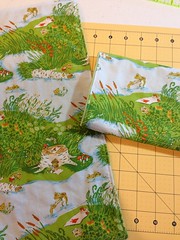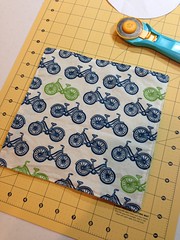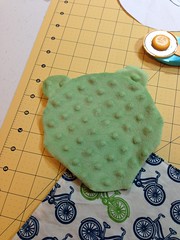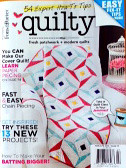I'll also give you a couple of tips to make working with slippery minky a lot easier. I've quilted with minky before, and I guest-posted over at Sewtakeahike a couple of years ago about the experience, if you're interested.
On to the tutorial!
Supplies
- Half yard of quilting cotton (I'm using a combination of frogs, bikes, dots, and moustaches)
- Half yard of minky (I found mine at JoAnn... you can find it with dots, stripes, or stars, and in a variety of colors)
- Set of snaps or velcro (I used sew on snaps)
- Pattern for the bib and lovey
- Scrap of batting
- Polyester fluff for stuffing
- Sewing supplies (machine, coordinating thread, hand sewing needle, scissors, rotary cutter and mat)
Notes
I pre-washed and dried the cotton and the minky... I wanted to pre-shrink it (the cotton) and get as much lint off the minky as possible--- I know baby items end up in the wash all the time, so this is a good idea if you'll be giving these as gifts!
Also, this is one of those projects where your sewing machine will thank you for starting with a fresh needle. And a sharp blade on your rotary cutter. Plus, when you're through, make sure you clean the minky lint out of your machine!
The Burp Cloths
Having used a lot (and I mean A LOT- Emma spit up regularly as an infant) of burp cloths, I got a good feel for what criteria were necessary to make a good one.
Number one at the top of my must-have list for a burp cloth is multiple layers... it has to be absorbent! I ended up with many burp cloths that were a single knit layer and totally useless after five minutes. Also important is texture... you'll want something nice and soft against baby's skin!
This burp cloth was originally inspired by MADE's tutorial. I changed the measurements to better fit my needs. I also altered the construction a little to make it easier... you'll see how in a minute!
1. Cut two rectangles from your quilting cotton that measure 9 x 16 inches. Cut two rectangles of minky that measure 10 x 17 inches.
2. Pin one rectangle of cotton to one rectangle of minky, wrong sides together.
TIP: Originally I cut both pieces the same size, and the minky slid all over the place during pinning and sewing. If you cut the minky bigger, you get a little wiggle room for sliding. But you still need to pin! And pin well! Learn from my mistakes, people. :)
3. Sew around all sides using a 1/4" seam allowance and the edge of the quilting cotton as your guide.
TIP: Use your walking foot, if you have one, and go at a moderate speed. If you go too fast, the minky will really shift everywhere!
Leave a 3" gap on one short end for turning. Trim the excess minky away from the seam allowance. Clip the corners and turn inside out.
I like to use a bone folder to make the corners nice and crisp... it has a nice point like a knitting needle or chopstick but won't go through the corner if I accidentally push too hard.
4. After you poke out the corners, press the burp cloth on the cotton side with your iron on a low setting. Minky is a polyester fabric and not really meant to be ironed, so we're just smoothing out the wrinkly cotton.
5. Pin the opening closed and topstitch around the edge of your burp cloth, about 1/8" away from the edge. This closes the opening at the same time.
6. Fold the burp cloth in thirds and mark the folds. (I used my bone folder to do this, or you could use a hera marker.) Sew on these marked lines. This just makes it easier to fold the burp cloth, plus it minimizes the shifting of the layers.
Make the second burp cloth just like the first!
The Bib
1. Print out the pattern for the bib and cut it out. Lay the template on an 8 x 10" square of quilting cotton and cut around it carefully with your rotary cutter or scissors.
2. Lay the cut piece of cotton on an 8 x 10" square of minky, right sides together. Pin the cotton to the minky. Sew around the edge, using the cotton as your guide, with a 1/4" seam allowance. Leave a 3" gap on one long side of the bib for turning.
3. Trim the excess minky away from the edge of the cotton. Clip into the curved edges of the seam allowance (but not all the way!) and trim some bulk around the curved pieces that go around the neck.
4. Turn the bib right side out (I used my bone folder again to get into the narrow channel of the neck straps.)
5. Press the bib on the cotton side.
6. Pin the opening closed and topstitch around the edge of the burpcloth, about 1/8" away from the edge.
7. Sew on the snaps or velcro, following package directions.
Done!
The Lovey
Here's a little secret about loveys... if Mama sleeps with a lovey for a couple of nights, it will take on her scent. This can comfort Baby in his crib at night!
1. The first part is just like making the burp cloth. Cut a piece of cotton 9 x 9 inches and a piece of minky 10 x 10 inches. Center the cotton on the minky, right sides together. Pin, sew around the edge with a 1/4" seam allowance, and leave a 3" opening for turning.
2. Trim the extra minky. Clip the corners and turn. Poke out the corners. Iron on the cotton side and pin the opening closed. Topstitch around the edge. This is now called the "lovey blanket". Set aside.
3. Print and cut out the lovey head and ear pattern pieces. Follow the cutting instructions on the pattern page and cut one head from cotton (exact size of template) and one from minky (about 1 inch larger than template all the way around). Also, cut two ears from cotton and two from minky.
4. Pair one cotton ear with one minky ear right sides together. Sew around the curve and clip the curved seam. Turn right side out and finger press. Repeat with other cotton ear and minky ear.
5. Sandwich the ears between the two head pieces which are right sides together. Sew around the cotton head using a 1/4 seam allowance and catching the edges of the ears. Leave a gap for turning. Clip around the head and turn right side out.
6. Stuff the head as firmly as you like. Turn the edges of the open seam under. Insert one corner of the lovey blanket and hand or machine stitch closed. Make sure the opening is closed securely as these items will be loved and washed regularly!
And there you have it!
I'd love to know if you use this tutorial to make a gift set for a special baby! Also, if you need clarification on any of the steps, email me and I'm happy to help!
















No comments:
Post a Comment